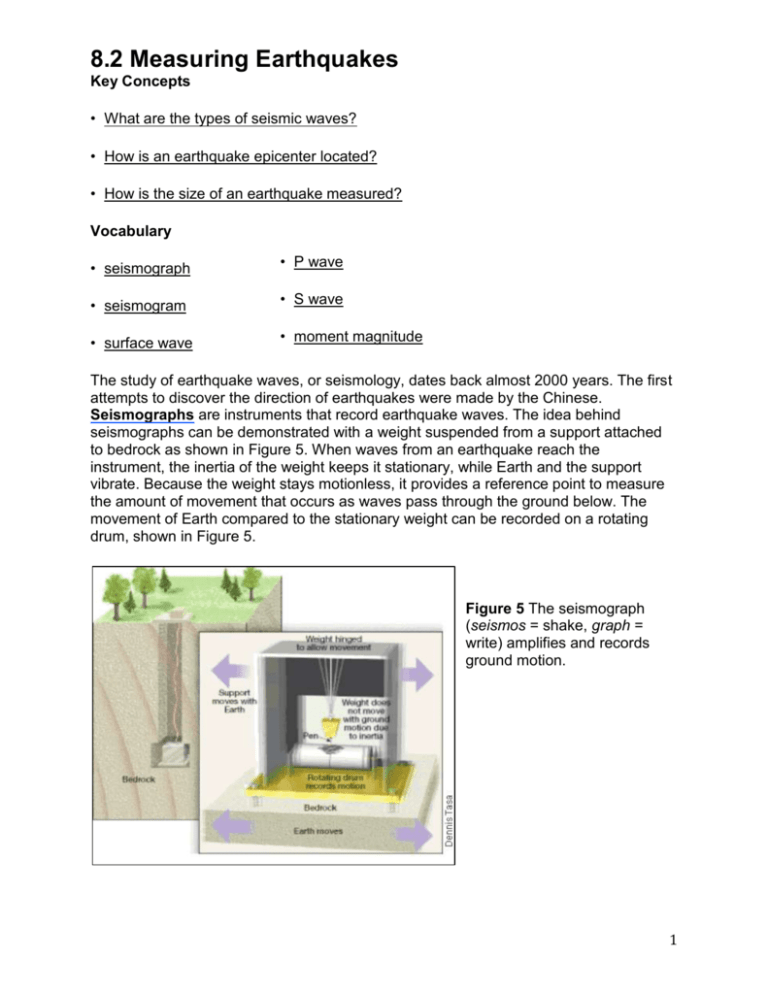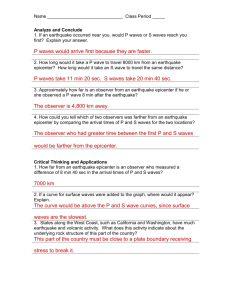8.2 Assessment Reading and Qs
advertisement

8.2 Measuring Earthquakes Key Concepts • What are the types of seismic waves? • How is an earthquake epicenter located? • How is the size of an earthquake measured? Vocabulary • seismograph • P wave • seismogram • S wave • surface wave • moment magnitude The study of earthquake waves, or seismology, dates back almost 2000 years. The first attempts to discover the direction of earthquakes were made by the Chinese. Seismographs are instruments that record earthquake waves. The idea behind seismographs can be demonstrated with a weight suspended from a support attached to bedrock as shown in Figure 5. When waves from an earthquake reach the instrument, the inertia of the weight keeps it stationary, while Earth and the support vibrate. Because the weight stays motionless, it provides a reference point to measure the amount of movement that occurs as waves pass through the ground below. The movement of Earth compared to the stationary weight can be recorded on a rotating drum, shown in Figure 5. Figure 5 The seismograph (seismos = shake, graph = write) amplifies and records ground motion. 1 Modern seismographs amplify and electronically record ground motion, producing a trace, called a seismogram. A typical seismogram (seismos = shake, gramma = what is written) is shown in Figure 6. Figure 6 Typical Seismogram The first wave to arrive is the P wave, followed later by S waves. The last waves recorded are the surface waves. Measuring What is the time interval in minutes between the start of the first P wave and the start of the first S wave? Earthquake Waves The energy from an earthquake spreads outward as waves in all directions from the focus. Seismograms show that two main types of seismic waves are produced by an earthquake—surface waves and body waves. Surface Waves Surface waves are seismic waves that travel along Earth’s outer layer. The motion of surface waves is complex. Surface waves travel along the ground and cause the ground and anything resting upon it to move. This movement is like ocean waves that toss a ship. Surface waves move in an up-and-down motion as well as a side-to-side motion, as shown in Figures 7E and 7F. The side-to-side motion is especially damaging to the foundations of buildings. These movements make surface waves the most destructive earthquake waves. (continued on next page) 2 Figure 7 Each type of seismic wave has characteristic motions. Body Waves The other waves that travel through Earth’s interior are called body waves. Body waves are identified as either P waves or S waves, depending on how they travel through the materials within Earth. Figures 7B and 7D shows differences between the two kinds of waves. P waves are push-pull waves—they push (compress) and pull (expand) rocks in the direction the waves travel. P waves are also known as compression waves. In contrast, S waves shake the particles at right angles to their direction of travel. This can be shown by fastening one end of a rope and shaking the other end, as in Figure 7C. S 3 waves are transverse waves. P waves temporarily change the volume of the material they pass through by alternately compressing and expanding it, as in Figure 7A. S waves temporarily change the shape of the material they pass through. Gases and liquids will not transmit S waves because they do not rebound elastically to their original shape. A seismogram shows all three types of seismic waves—surface waves, P waves, and S waves. By observing a typical seismic record, as shown in Figure 8 on page 225, you can see that the first P wave arrives at the recording station, then the first S wave, and then surface waves. The waves arrive at different times because they travel at different speeds. Generally, in any solid material, P waves travel about 1.7 times faster than S waves. Surface waves travel the slowest at about 90 percent of the speed of the S waves. Locating an Earthquake The difference in velocities of P and S waves provides a way to locate the epicenter. You can compare this difference to a race between two cars. The winning car is faster than the losing car. The P wave always wins the race, arriving ahead of the S wave. The longer the race, the greater will be the difference in arrival times of the P and S waves at the finish line (the seismic station). The greater the interval measured on a seismogram between the arrival of the first P wave and the first S wave, the greater the distance to the earthquake source. Earthquake Distance A system for locating earthquake epicenters was developed by using seismograms from earthquakes whose epicenters could be easily pinpointed from physical evidence. Travel-time graphs are constructed from these seismograms, as shown in Figure 8A. Using the sample seismogram in Figure 6 and the travel-time curves in Figure 8A, we can determine the distance from the recording station to the earthquake in two steps. First, find the time interval between the arrival of the first P wave and the first S wave on the seismogram. Second, find on the travel-time graph the equivalent time spread between the P and S wave curves. From this information, you can see that this earthquake occurred 3800 kilometers from the seismograph. 4 Figure 8 Locating an Earthquake A A travel-time graph is used to determine the distance to the epicenter. The difference in arrival times of the first P wave and the first S wave in the graph is 5 minutes. So the epicenter is roughly 3800 kilometers away. B The epicenter is located using the distance obtained from three seismic stations. The place the circles intersect is the epicenter. Earthquake Direction Now we know the distance, but what about the direction? The epicenter could be in any direction from the seismic station. As shown in Figure 8B, the precise location can be found when the distance is known from three or more different seismic stations. On a globe, we draw a circle around each seismic station. Each circle represents the distance of the epicenter from each station. The point where the three circles intersect is the epicenter of the quake. Travel-time graphs from three or more seismographs can be used to find the exact location of an earthquake epicenter. Earthquake Zones About 95 percent of the major earthquakes occur in a few narrow zones, as shown in Figure 9. Most of these earthquakes occur around the outer edge of the Pacific Ocean. This zone is known as the circum-Pacific belt. Active earthquake areas in this zone include Japan, the Philippines, Chile, and Alaska’s Aleutian Islands. A second zone of earthquake activity occurs along the Mediterranean Sea. This is the MediterraneanAsian belt. Another continuous belt extends for thousands of kilometers through the world’s oceans. This zone coincides with the oceanic ridge system. Figure 9 Distribution of the 14,229 earthquakes with magnitudes equal to or greater than 5 from 1980 to 1990. Observing Where do you find most of the earthquakes—in the interiors of the continents or at the edges? Measuring Earthquakes Historically, scientists have used two different types of measurements to describe the size of an earthquake—intensity and magnitude. Intensity is a measure of the amount of earthquake shaking at a given location based on the amount of damage. Intensity is not a quantitative measurement because it is based on uncertain 5 personal damage estimates. Quantitative measurements, called magnitudes, were developed that rely on calculations using seismograms. Magnitudes are a measure of the size of seismic waves or the amount of energy released at the source of the earthquake. Richter Scale A familiar but outdated scale for measuring the magnitude of earthquakes is the Richter scale. The Richter scale is based on the amplitude of the largest seismic wave (P, S, or surface wave) recorded on a seismogram. Earthquakes vary greatly in strength, so Richter used a logarithmic scale. A tenfold increase in wave amplitude equals an increase of 1 on the magnitude scale. For example, the amount of ground shaking for a 5.0 earthquake is 10 times greater than the shaking produced by an earthquake of 4.0 on the Richter scale. Seismic waves weaken as the distance between the earthquake focus and the seismograph increases. The Richter scale is only useful for small, shallow earthquakes within about 500 kilometers of the epicenter. Most of the earthquake measurements you hear on news reports use the Richter scale. Scientists, however, no longer use it. Moment Magnitude In recent years, scientists have been using a more precise means of measuring earthquakes. It is called the moment magnitude scale. The moment magnitude is derived from the amount of displacement that occurs along a fault zone. It doesn’t measure the ground motion at some distant point. The moment magnitude is calculated using several factors. These factors include the average amount of movement along the fault, the area of the surface break, and the strength of the broken rock: (surface area of fault) × (average displacement along fault) × (rigidity of rock). Together these factors provide a measure of how much energy rock can store before it suddenly slips and releases this energy during an earthquake. Moment magnitude is the most widely used measurement for earthquakes because it is the only magnitude scale that estimates the energy released by earthquakes. Table 1 describes the damage and incidence of earthquakes of different magnitudes. Compare this information to the earthquakes listed in Table 2. (see next page) 6 7 SECTION 8.2 Measuring Earthquakes Assessment Reviewing Concepts (1)List the three different seismic waves. (2)Briefly describe how the epicenter of an earthquake is located. (3)Describe the two different ways to measure the size of an earthquake. (4)In what order do the basic types of seismic waves reach a seismograph? Critical Thinking (5) Comparing And Contrasting Describe the differences in speed and mode of travel between primary waves and secondary waves. SECTION 8.2 Measuring Earthquakes Assessment Reviewing Concepts (1)List the three different seismic waves. (2)Briefly describe how the epicenter of an earthquake is located. (3)Describe the two different ways to measure the size of an earthquake. (4)In what order do the basic types of seismic waves reach a seismograph? Critical Thinking (5) Comparing And Contrasting Describe the differences in speed and mode of travel between primary waves and secondary waves. 8








